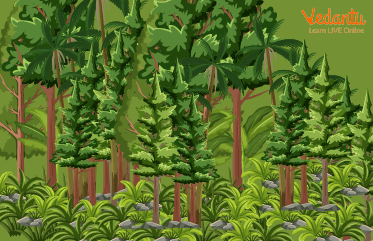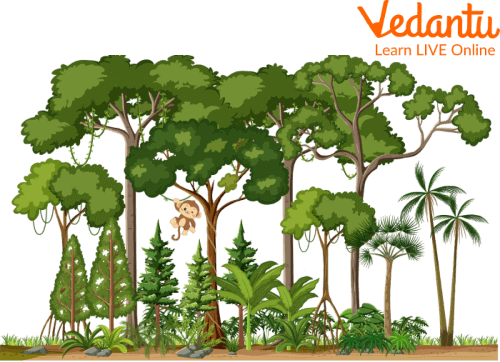




Introduction to 5 Layers of Rainforest
A forest is a section of land where both little and huge trees are present. The temperature and amount of rainfall are used to classify the forests. The term "rainforest" refers to a forest with high annual rainfall and warm winter and summer temperatures. Let's have a look at the main layers of a tropical rainforest.

Rainforest Picture
Every year, the rainforests receive between 250 and 450 centimeters of rain. The typical temperature in these woodlands is above 90 F (32 degrees C). Although they are distinct from one another, jungles and rainforests are occasionally mistaken. Tall trees that cover the top of the forest in a rainforest obscure the majority of the sunlight.
A jungle, on the other hand, is not a constrained area; it may have little trees, taller trees, and open grassy fields. We will also learn about the canopy layer of the rainforest and an emergent layer of the rainforest.
What are the Layers of the Rainforest?
The creatures that inhabit the rainforest have adapted to exist in a certain layer of the forest. The main layers of a tropical rainforest contain a variety of flora and animals.
Emergent Layer of the Rainforest: The longest trees among the layers are in the emergent layer. These trees might grow as tall as 55 meters. The number of trees in this layer is, however, lower than in the canopy layer. The main inhabitants of this layer include bats, eagles, and monkeys.
Canopy Layer of the Rainforest: Except for a few trees in the emergent layer, this layer contains most of the longest trees. The height of the trees in this layer ranges from 35 to 45 meters. Additionally, this layer contains roughly 50% of all plant species.

Layer of Rainforest
Understory Layer of the Rainforest: In a rainforest, the understory layer lies in between the canopy layer and the ground level. In this layer, there are numerous insects and huge leaves on the plants. Jaguars, leopards, lizards, snacks, and many other species can also be found in this tier. The canopy layer receives the majority of the sun's energy. As a result, only around five per cent of sunlight reaches the understory layer.
Forest Floor of the Rainforest: The ground layer of the rainforest is known as the forest floor. Of all the layers, it receives the least sunshine (almost 2%). The majority of the plants that can endure low light are found in this stratum. This layer collects all of the dead plants and their leftovers, which decompose swiftly.
Types of Rainforests
Due to its existence in places with varying temperatures, the rainforest is classified into these two categories. Both tropical and temperate rainforests fall within these two categories.
Tropical Rainforest: Near the equator, in the warm part of the world, are tropical rainforests. The climate in these woodlands is humid. They get more than 170 cm of rain each year, although certain tropical rainforests can get up to 1000 cm. A sizable portion of the world is covered in tropical rainforests. The Philippines, Sri Lanka, South America, Indonesia, Australia, and Malaysia are a few nations with tropical rainforests.
Temperate Rainforests: Temperate rainforests are found where the temperatures are mild throughout the year. They can therefore endure frigid temperatures. These forests are only found in a few places on earth. These forests can be found in North America, Alaska, Scotland, Ireland, and Norway.

Rainforest
Summary
In this article, we discussed what rainforests are. The main emphasis was on the layers of rainforest - emergent, canopy, understory, and forest floor. We also talked about two types of rainforests which are tropical and temperate forests. Forests are vital to life on earth. It is important to us in many ways. If we want to protect ourselves and our planet, then we will have to protect and preserve the forests. We should stop cutting trees unnecessarily.
FAQs on Layers of Rainforest
1. How important are rainforests for humans?
The earth's green tint comes from the vast amount of rainforest that covers it. They consume roughly the same quantity of oxygen at night; thus, the rainforest produces very little net oxygen during the day. However, the production of oxygen is greatly influenced by rainforests like the Amazon.
When it rains, valuable minerals produced by decaying dead plants wash into the water. Plankton and other tiny sea creatures eat these minerals. Most of the oxygen on earth is produced by plankton. Rainforests also influence how clouds form and provide a variety of medicinal herbs and timber.
2. What do you mean by deforestation?
Deforestation is the loss of forest habitat for purposes such as urban development, farming, or mining. It occurs all around the world. Deforestation, which has been significantly increased by human activity since 1960, has been detrimental to natural ecosystems, biodiversity, and the climate.
Human activity is the main factor contributing to the decline of forests. To remove land for their use, humans have been destroying forests. Numerous species have been classified as endangered, and if specific steps are not followed, they could become extinct.
3. Write some roles played by rainforests?
Rainforests play a very important role in our life. They purify the air that we are going to breathe, stop soil erosion, prevent global warming, and filter the water we drink.
4. Which is known as the green-blanket layer?
Canopy is known as the green-blanket layer.
5. Which layers of rainforest do not get enough sunlight?
The forest floor and the understory are the layers of rainforest that do not get enough sunlight.









